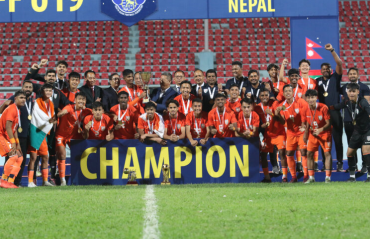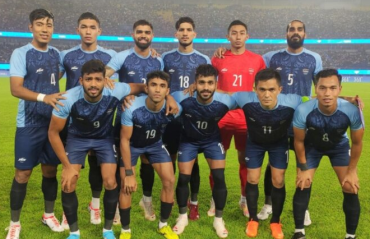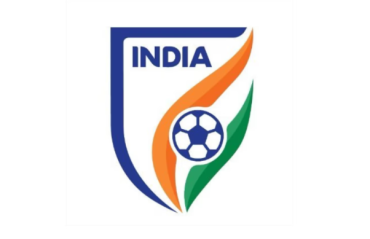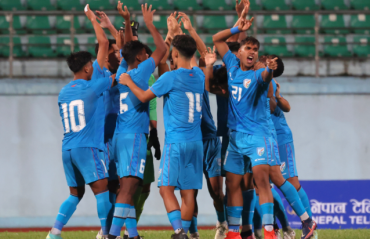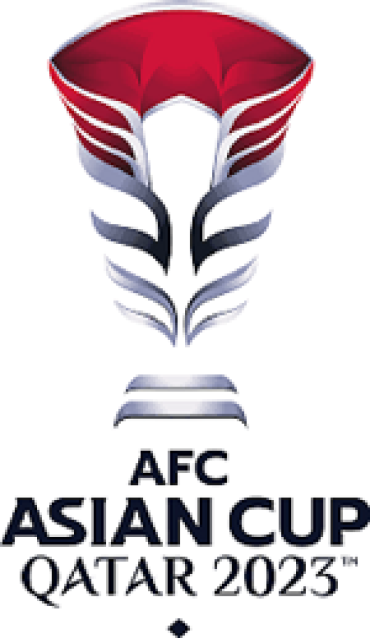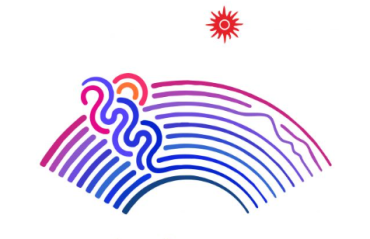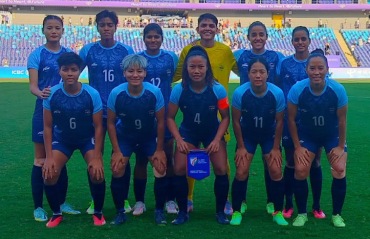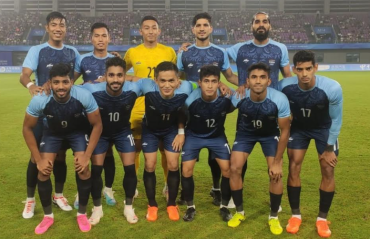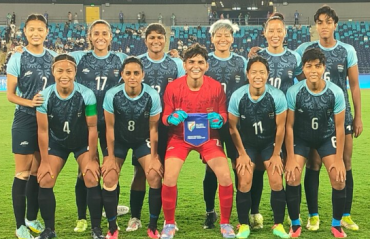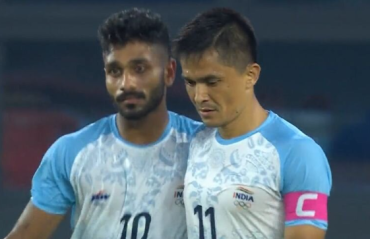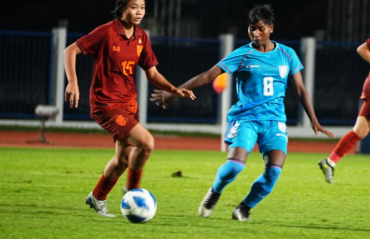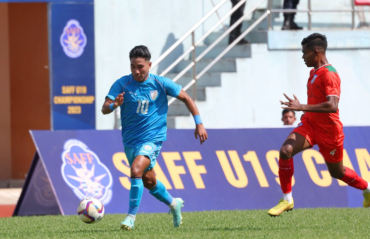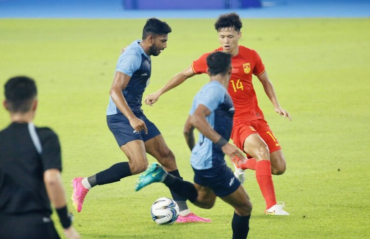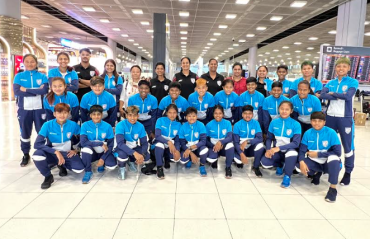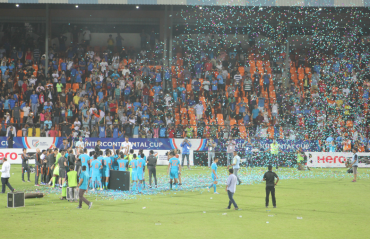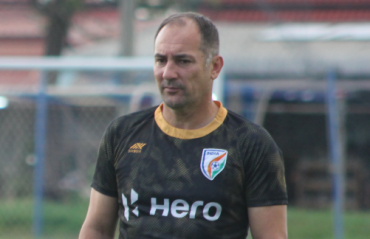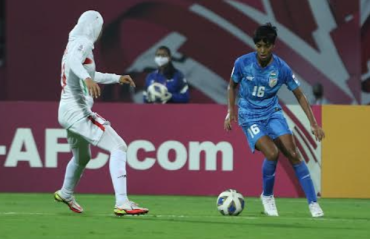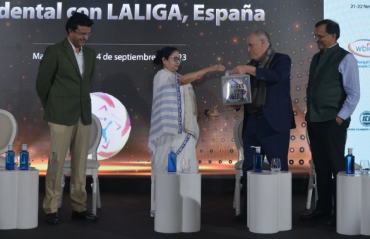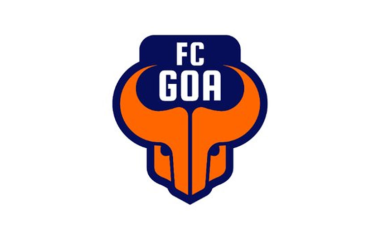SUNBURNT TERRACE: the U-17 World Cup is over, but the issues plaguing Indian football are not
- By Chiranjit Ojha

- October 30, 2017

THE MONTH OF OCTOBER saw the world of Indian football turn upside down; in a good way, for a change.
Over the past few years, the main source of turmoil has been the constant push-pull between the country's biggest football clubs and franchises, the All India Football Federation and their commercial partners IMG-Reliance. Even the ISL broadcasters and partial owners Star Sports, some local associations like West Bengal's IFA, and certain player agencies also played their part in what seemed like a clash of differing visions at times, sometimes a struggle for autonomy and often just a clash of over-inflated egos.
But amidst all the uncertainties, October 2017 was a breath of fresh air. India hosted its first World Cup tournament. India's U-17 squad, groomed for years for this big moment, finally made their walk to the middle. The Indian national anthem was played at a FIFA competition for the first time. Our boys didn't exactly exceed expectations but put up a hard fight. The attendance broke the all-time record for the U-17 World Cup. Our captain walked out with the winners' trophy. And we experienced the rise of a new world order with England's triumph in the thrilling finale.
To top it off, AIFF president Praful Patel announced to an impressed FIFA head Infantino that India would bid for the U-20 World Cup and the Club World Cup as well.
For a while, rather than worrying about the flaws in the clubs' grassroot efforts, the fans got to behold the fruit of labour that thousands of AIFF & FIFA officials and volunteers have been working tirelessly to produce for the last two years. Instead of constant complaints about infrastructure, newly renovated FIFA-funded state-of-the-art stadiums opened up to the public.
For a brief while, India was at the centre of the footballing world's attention. A narrative of "India have arrived" was pushed forth in the talking points.
Now that all the jubiliation of having a football World Cup take place at our own country has passed, we are faced with the unpleasant task of turning our focus back to the hard ground realities of Indian football. The old stuff about ISL, I-League, merger, promotion-relegation... the debate that has been going on forever and has turned increasingly toxic over time.
The sheer tranquility of not addressing all that again is very tempting. Indeed, it has been about a year since this column last made an appearance. Partly because at the height of negotioations between IMG-Reliance, AIFF, AFC, FIFA and I-League clubs it seemed approprate to let the process play out first before dissecting it to death. And partly due to some surreal on-field developments that few saw coming.
Long story short, the merger attempt failed. AFC have been speaking in favour of unifying the Indian league structure since they first set up a joint committee to make it happen, and they are still doing that today. IMG-Reliance have been pushing to expand ISL and eventually have it established as the new top division league minus promotion-relegation and with a hefty franchise fee. AIFF have been basically nodding at AFC's suggestions and doing whatever IMG-Reliance asked them to do. And I-League has been looking like a leaking boat that nobody wants to be on if they have the choice: Bengaluru FC switched to ISL, DSK Shivajians pulled out, while the Kolkata giants East Bengal and Mohun Bagan shot themselves at the feet by getting political parties involved and orchestrating a self-centred mess of a "rebellion" when they should have been on the negotiations table, talking to AIFF, IMG-R and AFC with at least some degree of integrity.
And in a rare stroke of pure footballing justice, the crown of Champions of India went to Aizawl FC, which basically poured a big bucket of ice water on the bigwigs' "half merger" plan.
"Half merger", because the original plan for "resturcturing" India's leagues, cooked up by IMG-R and approved by AIFF, involved moving a handful of clubs from I-League to ISL, making ISL the new top tier, shutting down I-League, and introducing League One and League Two as the lower leagues. This course of action involved forcefully relegating most of the top division clubs to the second tier (League One), and shutting down their path back to the highest league (ISL) by abolishing promotion-relegation between the first and second tiers.
Other than the negative implications of unfairly shoving top division clubs down to the second tier and keeping them there, the central arrogance of this plan lay in the implied assumption that one of East Bengal, Mohun Bagan or Bengaluru FC would win the I-League 2016-17. But unfortunately, Aizawl FC pulled off a miracle and became champions. And unlike most other clubs, their passionate support base and politically well-connected owners were ready to kick up a storm if somebody tried to relegate them after winning the league. There were even threats of mass protests and hunger strikes. The union sports minister got involved, the Mizoram chief minister was making statements, the unfair treatment of Aizawl FC was on the verge of becoming a major political issue and elections were not far away.
AIFF had been beaten at its own game. It seemed almost impossible for them to save face. Aizawl FC, being a club with a budget of Rs 2.5 crore, were never going to agree to a move to ISL with a Rs 15 crore franchise fee. And there was no way IMG-Reliance were compromising their profit motive to let the Champions of India avoid a forceful relegation. AIFF were caught in the middle of a staredown between their champion club and their commercial partners, with seemingly no middle ground. And this is where East Bengal and Mohun Bagan helped them out.
There are two points of contention when it comes to EB and MB's migration to ISL. Firstly, it's the infamous "one city one club" rule. The original contract penned between Football Sports Development Limited (FSDL, the operating arm of IMG-Reliance) and the ISL franchise owners states that no other ISL franchise can come up within a 50 kilometer radius for the first 5 seasons. This allowed Atletico de Kolkata - now simply ATK after their Spanish partners Atletico de Madrid pulled out of the franchise - to claim exclusivity over the city of Kolkata. This in turn meant that East Bengal and Mohun Bagan would have to move out of their home city of more than a century for 2 years if they moved to ISL in summer 2017.
This ridiculous temporary exile, which is clearly detrimental to both the clubs and the sport in general, does nothing but to help preserve ATK maintain a shaky monopoly. The franchise came into existence offering big discounts to the members of East Bengal, Mohun Bagan and Mohammedan Sporting. Ever since then they have been running from a direct clash with these three clubs, which command loyalty of the bulk of the football fans in Kolkata.
ATK are so dependent on the second hand support of EB & MB fans that when given a chance to play in the Calcutta Football League, they chose to field a "junior" team in the 3rd Division (5th tier) to avoid having to play EB or MB. Their social media handles, constantly beefed up by bots, mostly ignores the existence of this "junior team." And then, this summer, ATK pulled out from participating in the IFA Shield U-19 tournament at the last minute, once again to avoid playing against EB, MB or MDS. Pune City's academy team (formerly Pune FC Academy) went on to win the trophy, which would go down in history as the first time an ISL team won something other than ISL.
Hoping to switch the loyalties of a large enough chunk of EB & MB supporters, ATK desperately want to avoid being in the same league or tournament. That's why blocking EB & MB from coming into the ISL, or forcing them to get out of the city for a while, is something they have been fighting for with tooth and nail. And neither AIFF nor IMG-Reliance have been able to move them from their anti-competitive, monopolistic ways. Mainly because the ISL itself is a tourament built to establish and preserve monopolies. But that's just one issue.
The other issue is that of the franchise fee. East Bengal and Mohun Bagan want to play in ISL but don't want to pay the Rs 15 crore fee like the other teams in the league. The EB & MB officials claim that because they have been around for a century and helped to build the football culture in India that ISL today stands on, they should be exempt from paying the hefty fee. This piece of logic is not very convincing; especially when one looks at the situation surrounding the two clubs.
Despite the club officials' insistence that EB & MB's participation in ISL hinges on these two aforementioned factors, there are multiple currents of intra-club powerplays that they are trying to sweep under the rug.
The fact is, the franchise fee is not going to be a big issue for either club. East Bengal had been assured that their chief sponsors Heineken (who own the Kingfisher brand) would pay the franchsie fee for them, and even re-work their existing agreement to create what would become the biggest sponsorship deal ever in Indian football. Even Mohun Bagan, who have been without a main shirt sponsor for the last 2 years because of their long-running court case with former sponsor McDowell's, will face no trouble in getting a similarly large sponsorship deal. Joining ISL is likely to turn them into two of the richest clubs in the country.
And when they bring large sponsors and countless dedicated fans into the ISL fold, IMG-Reliance would have a large enough incentive to work out the "one city one club" situation and prevent the unfair exile of two of their most valuable clubs.
But neither East Bengal nor Mohun Bagan went that way. Instead, we saw a pointless feud between them and AIFF/IMG-R where even the Bengal chief minister got involved. The clubs, despite picking up ISL bid documents, did not submit them, and the efforts to re-structure the leagues died. Or rather, got postponed till the next year.
The reason they did that was because of some officials' selfishness. Both East Bengal and Mohun Bagan would have to re-organize their own administrations if they brought in large sponsors. There would have to be a professional CEO appointed, and new governing bodies where the sponsors would be represented. This meant a few officials would lose their position of power within the clubs. So these officials from both clubs conspired to sabotage the whole thing.
Unfortunately, while hundreds of thousands of East Bengal & Mohun Bagan fans put the clubs ahead of themselves, certain officials in both clubs put themselves ahead of the clubs. And their shameful behaviour allowed AIFF and IMG-Reliance to abandon the efforts to push through the re-structuring this year, and they were let off the hook for their little ethical crisis regarding Aizawl FC.
And so we have a situation where I-League remains the official top division for now, but ISL - now given a provisional recognition by AFC as a Federation Cup replacement - continues to get all the preferential treatment from AIFF and IMG-R they need. Star Sports will show both leagues but all the better time slots have been given to ISL. Multi-lingual TV & digital advertising campaigns have been blaring the arrival of ISL for more than a month, but not a single ad has been made for I-League. The ISL fixutures have been out forever, but I-League match dates are still being finalized; mostly because it seems almost impossible to properly organize and televise the top division league with the constant requirement to step aside for ISL.
And even with everything being served up on a platter, ISL is not enjoying a smooth run. Multiple franchise owners have been privately complaining about the losses they are continuously facing. Some want out. FC Goa, Delhi Dynamos have changed hands already. Atletico de Madrid have abandoned ATK. At least three other franchise owners are looking to offload the bulk of their shares. The promise IMG-Reliance made to the prospective franchise owners that they would start turning profits within five years is looking less likely every other day.
But problem stems from the fact that most franchise owners thought they were getting into an IPL clone. All this mess about merging leagues, getting club licenses, building academies and engaging in all-year youth development were not anticipated by them. There was a requirement for doing "grassroot festivals" (glorified photo ops) and the franchises were given 5 years to build an academy; luxurious relaxation of rules that even 2nd Division League clubs don't get to have. But now with AFC getting involved and media focus shifting to India's junior teams, there is push for building youth teams that play in U-18 & U-15 Y-League plus the trend of fielding B-sides in 2nd Division. This adds to the operational cost, on top of an already expanding cost due to a longer season.
The fact that many of the ISL franchises are still unable to take on the responsibilities of a full-fledged club becomes apparent by the way the transfer market had to be handled. To limit the mounting losses, IMG-Reliance limited franchises' player salaries to Rs 17 crore, and brought down the number of foreigners per squad from 10 to 8. And lest this led to a significant increase in Indian players' salaries (fuelled by increased demand due to I-League clubs and ISL franchises competing to sign players), ISL reverted to the old Draft system for Indian players. This saw the transfer market being monopolized by IMG-Reliance; players could not directly negotiate with clubs to get a higher salary, and the franchises could simply turn up and pick players out of the pool. A monopoly to preserve another monopoly.
Ironically, neither of the new entrants, Bengaluru FC and Jamshedpur FC, needed this babysitting with their transfers. The organizations behind both these teams have been active in football far longer than the original 8 ISL franchises. Indeed, the player retention limit set by ISL forced Bengaluru FC to break up the well-rounded and successful squad that they had built up over 4 years. For them, it might even be a bit of a struggle to adjust to life in ISL, where ridiculous rules take away the players you want to keep, and require franchises to get an approval from the league's organizers before signing a foreign player and even appointing a coach. Especially when the people in charge of issuing said approvals don't seem to consider Indian coaches to be good enough to become head coaches of ISL franchises, and think it's a good idea to let Nicolas Anelka become a manager, or greenlight the likes of Roberto Carlos, Alessandro del Pierro or Robert Pires to play.
Behind an outer shell that's designed to project a homogenous "professionalism", ISL functions as a system that centrally controls every aspect of how its franchises function. It's a mechanism that by definition requires the teams to be inept enough to recognize that they can do better under the league organizers' supervision than on their own. That's where perks like exclusivity over a city and safeguard from the threat of relegation comes in; to help create a structure of dependence that ensures a steady inflow of cash in the form of franchise fees and other little bills and fees earned through "added services" (event management, hospitality, security etc) provided by IMG-R's partner companies.
For clubs like East Bengal, Mohun Bagan, Bengaluru FC and that can function on their own, this should be a bigger concern than any other when it comes to becoming a part of ISL. But none of them seem to be interested in addressing that as of now. Everyone wants a piece of the promised profit pie that IMG-Reliance have offered to those who toe their line.
Ironically, while all the "professional, ambitious" big spenders continue to lose crores of rupees every season, the only club turning a profit today is the low-budget Aizawl FC. And they are the Champion of India; the only Indian club who will play in the prestigious AFC Champions League qualifiers in 2018. Their very presence demolishes every ideal propped up by ISL. They are not a club that spends big. They rose to the top division by merit through promotion-relegation, not by paying big money to get into a closed league. And they built a squad from the open market that made them the Champions of India, something no ISL franchise can be as of now. And in terms of youth development they have left almost all ISL franchises behind despite having about 10% the budget of a typical ISL team; with seven dedicated grassroot centres, a residential academy and scouting drives in Mizoram and Manipur either already in operation or about to be launched within the next year.
Of course, being such an inconvenience to the ISL model, Aizawl FC will be priced out of the new top division league when the restructuring finally happens. To avoid a forced relegation when the leagues are re-structured they will have to become champions again. And no one seems to be bothered about the inherent unfairness of this. Not the Federation, not even the other clubs in the same situation, like Shillong Lajong and Churchill Brothers. Everyone knows I-League's days are numbered, and have either accepted their fate of eventual relegation, or have started cosying up to IMG-R for a place in ISL in latter seasons.
Ironically, the proponents of a closed top league minus promotion-relegation have no problem forcefully relegating existing top division clubs. The end goal, once again, is to consolidate the monopoly that is the ISL, and increase the inflow of franchise fees. Whether or not it discourages competitve spirit in lower leagues and thereby lowers the amount of effort the clubs put into spreading the reach of the sport in communities untapped by the top flight clubs is not a factor as long as the immediate needs of the ISL organizers are taken care of.
But at the end of the day, intentions matter. Clubs are supposed to aspire to win matches and rise as high as they can within their limited means. If the management's foremost intentions are to start making money in 5 or 10 years, especially in a country like India where popularizing football is clearly a long term task, it shows in the way they run the club, and they make compromises in the quality of football they play. And clubs where football is undermined seldom become successful. And that's why these franchises need to be kept alive with new incentives and promises. FIFA U-17 World Cup was one such promise. IMG-R convinced many franchises that the mega event would popularize the sport which would increase TV viewership and sponsorship money for the ISL teams. This is a flawed argument at best; but they are rolling with it for now.
There is also the effort from AIFF to try to host the FIFA Club World Cup right after ISL officially becomes the top division league. If successful, it will give the ISL champions a chance to play in the biggest club competition in the world, by virtue of being from the host country. The aim is to boost the profile of ISL and bring in new investment; especially from abroad. Foreign money is the main way closed leagues like MLS and A-League have prolonged their survival. So far, ISL has failed to procure much of that, and the organizers are desperate to change it. One problem here is the fact that ISL franchises by themselves don't offer much value. They are basically 10-year rental teams, and unlike MLS, owining a team does not make one stakeholders of the league itself. So there is no sense of permanence, coupled with unnecessary meddling from the organizers in the matters of budget & player transfers, which turns off the real investors; the ones who come in with matured, long term visions to grow the club and the sport.
The existing ISL model does not serve the clubs or the national team. Not allowing franchises to be fully independent entitities, or giving them a false sense of security by not having promotion-relegation, holding playoffs at the end of the regular season that allows mediocre teams to rise to the top; it all serves to hinder the franchises from fully experiencing the compeititive nature of league football. Hence, their natural growth as clubs gets affected. Which makes them more dependent on the adult supervision of the ISL organizers. And the vicious cycle continues.
Perhaps with time as the new team owners gain more experience and the number of experienced sides like Bengaluru, East Bengal and Mohun Bagan increase in ISL, these restrictions will be relaxed. But somebody on the inside will have to stand up and demand these changes. And it won't be easy; because they will be asking for an end to the monopoly from which they themselves would stand to gain.
But with the franchises complacent within the relegation-proof ISL bubble, and future ISL clubs like East Bengal and Mohun Bagan also falling in line with the IMG-R prescribed frame of operation, Indian football is set to be re-structured to accommodate that same structure of monopoly. Anyone falling outside that new structure is facing the grim prospect of surviving with their path to the top tier suspended indefinitely. So what incentive do they have to invest heavily in the sport and leave a mark in the footballing landscape with their grassroot efforts? The bigwigs have no answer.
We just hosted the U-17 World Cup. The Indian national team is on a winning streak, and just qualified for the Asian Cup. For now, the world sees India as a nation that is moving forward. But the complex reality and unpleasant aspects of domestic football in India are slowly coming back to the forefront. As ISL gets underway on 17th November, and I-League on some date around the same time yet to be revealed to the fans, these issues will need to be addressed and discussed as the AIFF, IMG-R and AFC sit down finally map out the future path for Indian football.
Roughly speaking, they will have two choices. One that goes down the long, hard road of all-inclusive development, and another that tries to maintain the ISL's structural status quo with the promise of quick profits that sounds great to certain franchise owners.
As of now, it seems inevitable that India will be heading towards the latter. The question is, for how long.
Get the latest in the world of Sports, Teams, and Players! Free Delivery to your Inbox.









